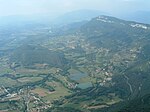Col du Chat

The Col du Chat is a mountain pass located in France, in the commune of La Chapelle-du-Mont-du-Chat, in the French department of Savoie in the Auvergne-Rhône-Alpes region. It crosses the Mont du Chat in the Jura Mountains, overlooking Lac du Bourget opposite the town of Aix-les-Bains. Although it has never been crossed by a main transalpine route, the pass has been crossed by a road since ancient times, and its use has often gone beyond the strictly local, at least until the Chat tunnel was opened: Montaigne, for example, used it on his way back from Italy. Today, it is used mainly by tourists, as a climb for cyclists, or as a starting point for hikes to Mont du Chat. Because of the region's particular flora and fauna, the pass is located within the perimeter of and close to natural zones of ecological, faunal and floristic interest and Natura 2000 reserves. The pass is open all year round, with no winter shutdowns.
Excerpt from the Wikipedia article Col du Chat (License: CC BY-SA 3.0, Authors, Images).Col du Chat
Route du Col du Chat, Chambéry
Geographical coordinates (GPS) Address Nearby Places Show on map
Geographical coordinates (GPS)
| Latitude | Longitude |
|---|---|
| N 45.692777777778 ° | E 5.8472222222222 ° |
Address
Route du Col du Chat
Route du Col du Chat
73370 Chambéry
Auvergne-Rhône-Alpes, France
Open on Google Maps








